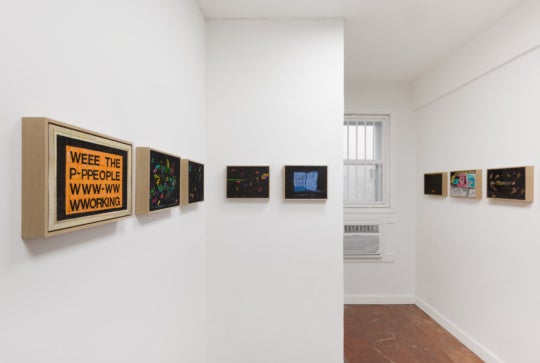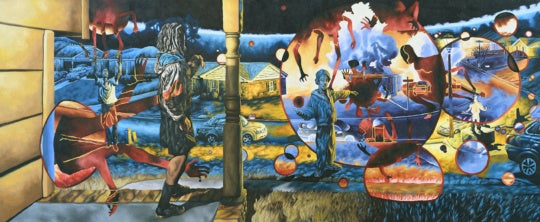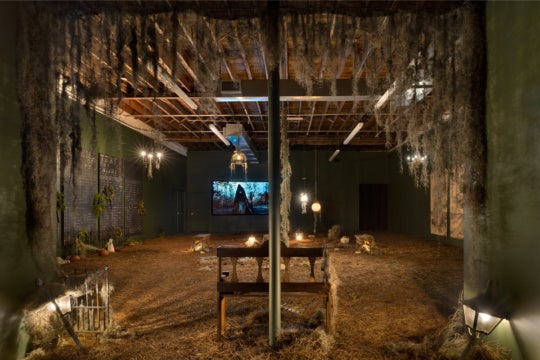
The Atlanta History Center opens a new series of gallery-based experiences with Four Days of Fury, a production by resident playwright Addae Moon [now in its final weekend, February 22-24]. This ambitious undertaking blends primary and secondary source material—historical documents and first-person accounts with fictional scenes in order to shed light on the obscured history of the Atlanta Race Riot of 1906. The resulting production cleverly integrates facts and dialogue to convey the importance of the events and their continued relevance and instill a haunting sense of empathy within the audience.
The Atlanta Race Riot encompassed four violent days—September 22-26, 1906—in which white mobs killed dozens of blacks and inflicted damage to black-owned businesses and neighborhoods. Historians describe a complicated combination of factors that led to these horrific events, including a tense gubernatorial race mixing with rising racial tenions. Four Days of Fury attempts to reconcile these emotions, fears, and facts in a journey that takes viewer-particpants through multiple sets, led by a narrator—black journalist J. Max Barber, played by Masud Olufani, who both guides the audience and interacts with other actors.
Barber shepherds viewers though scenes that instill a sense of the dangerous attitudes and injustice of the times. We begin with a rehearsal of Thomas Dixon’s The Clansman (1905), a play influential in the revival of the Ku Klux Klan, and are led next to the bigoted courtroom of Judge Nash R. Broyles, who rained excessive fines and punitive judgments upon any black unfortunate enough to end up in his court. We journey to a black saloon on Decatur Street where a white woman tells a black Clark University senior that despite the fact that he’s an educated young man happily engaged to another woman, her father would “beat me within an inch of my life and string you up” if he saw the two of them conversing.

Four Days of Fury offers a glimpse into Jim Crow Atlanta, rife with racial tensions and sensationalized by white fears. This information is imparted not just through the production itself, but also through the interactive components utilized to create empathy. Before entering the gallery, each visitor is given a name tag which reveals the word “black” or “white;” this determines the audience seating within the various sets based on segregation constraints. If you’re handed a “black” card, prepare to stand for the full hour of the performance; if you are “white,” brace yourself for the uncomfortable acceptance of your privileged status as you sit while those around you stand. Our 21st century attitudes jar harshly with these imposed restrictions, yet as audience members we go along. Though it’s just an act, we are tricked into becoming complacent with the status-quo set by the play, creating a complicated discomfort that increases the impact of the experience.
The casting is purposely color and gender-blind in a nod to the sensitivity of the material. Strangely, however, the actor playing Judge Broyles dons a grotesque putty-colored mask with exaggerated furrows and bulbous nose, which seems to run counter to the visual portrayals of race in the rest of the production. Overall, the mutability of color and gender is to be applauded, and has a meta-effect of emphasizing the horror of the attitudes portrayed in the play.
Four Days of Fury effortlessly brings historical documents to life—as in the reenactment of Judge Broyles’s courtroom based on court records—but at times struggles to create believable dissenting voices. When one of the actors from The Clansman re-enactment decries the ridiculousness of a scene taken from The Clansman (in which a doctor sees the image of a black man in the eyes of a dead women—“proof” that the black man was the murderer), it’s unclear whether the white actor’s discomfort would be historically accurate or is the imposition of a modern viewpoint. It’s as if the actor is giving voice to the frustrations of the audience members. Though there’s some catharsis in having our complaints spoken, it feels inauthentic.

Equally disorienting is the nonchalant tone of the woman who relates her father’s eagerness to beat her and hang a black man who looks at her the wrong way. Moon’s dialogue in Four Days of Fury wavers between the heated accusations between Barber and a newsboy—an all-knowing character who, despite his perfect knowledge of events, wavers in his moral choice—that energize the play and casually-delivered viewpoints that illustrate the complacency of the times. The latter jar against the tension that builds throughout, but Barber does not lose the pace and drives the audience towards the riot we know is coming.
Yet when the violence occurs, it’s swiftly over, and we are left in the reflective aftermath. Barber talks us through the press’s hushing of the incident and the deal-making that occurred between black business owners and white elites, portending a compromise that he suggests still affects Atlanta today. Atlanta’s Pittsburgh neighborhood is mentioned as a site of past and current strife, and the play implies today’s businessmen are continuing to uphold compromise to the disadvantage of less-powerful factions (the recent controversy over statements made by Emory’s president James Wagner are a timely case-in-point). Barber suggests Atlanta became “the city too busy to hate”—a reference to the city’s mid-century motto—because “you can’t hate what you don’t remember.” This idea cuts to the core, implicating the audience as participants in the attitudes that led to the downplaying of the Atlanta Race Riot, both in its immediate aftermath and in its forgotten status today.
Though parts of Four Days of Fury are shaky, the play imparts a firm sense of both the history of the events and their continued relevance in contemporary dialogue. As viewers we pass through Four Days of Fury like voiceless, spectral figures, helpless against the rising tide. Moon suggests that although the events of the 1906 Race Riot have passed, a dangerous complacency towards history lingers that we must shed. In the performance of Four Days of Fury, history comes alive; we are charged by the experience to keep it so.




